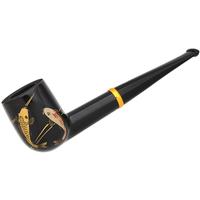If this is true—and it very well could be—then would the tobacco taste better if the crystals were rubbed off? I would assume so, although this would only be practical to do on flakes.“It’s actually not sugar crystals as commonly believed—taste it and you’ll see it’s not sweet at all. It’s primarily potassium nitrate and ammonium chloride—which are salts.”
Science of Plume/Bloom/Crystals on Tobacco
- Thread starter Val
- Start date
You are using an out of date browser. It may not display this or other websites correctly.
You should upgrade or use an alternative browser.
You should upgrade or use an alternative browser.
Correct, yet much better than make believe!The very definition of "modern science".
Over the past few years, the two have become nearly indistinguishable.Correct, yet much better than make believe!
Not if you actually read source material. I don't do it often, but fact based science exists.Over the past few years, the two have become nearly indistinguishable.
-dobbs
Depends on who is funding the source material.Not if you actually read source material. I don't do it often, but fact based science exists.
-dobbs
If the source material is that controversial, it needs to be peer-reviewed. You guys need to take off the tinfoil hats.Depends on who is funding the source material.
-dobbs
Not everything is a conspiracy theory and tin foil is no longer made of tin. To not recognize that the money behind the research has an impact on the results is naive.If the source material is that controversial, it needs to be peer-reviewed. You guys need to take off the tinfoil hats.
-dobbs
No tinfoil hats when results can be paid for. Following science unquestioningly is almost as bad as believing science is the answer when it's just a means to an answer though not always the correct one. Google Bayer + AIDS.You guys need to take off the tinfoil hats.
It's sort of like Bigfoot. I could post a $1,000 reward to anyone who produces a lab report of a single Tobacco sample that concludes "plume" actually exists but until then all scientific data shows it's gonna be a mold/bacteria/fungi.
People get all pissy though expecting you to somehow prove "plume" instead doesn't exist. Like how am I supposed to prove Bigfoot doesn't exist?
It's a bedtime story people tell themselves that turns a neutral or harmful by-product on their old Tobacco into something coveted.
It's a tool for tobacconists to sell something instead of throwing it away. Of course Tobacco producers want to support and spread the idea of plume. They could produce a lab test in a heartbeat with their resources to explain "plume" but for obvious reasons don't.
People get all pissy though expecting you to somehow prove "plume" instead doesn't exist. Like how am I supposed to prove Bigfoot doesn't exist?
It's a bedtime story people tell themselves that turns a neutral or harmful by-product on their old Tobacco into something coveted.
It's a tool for tobacconists to sell something instead of throwing it away. Of course Tobacco producers want to support and spread the idea of plume. They could produce a lab test in a heartbeat with their resources to explain "plume" but for obvious reasons don't.
What if plume is more than one single thing or made up of number of different substances? And what if mold is a part of it? Bring back the tinfoil hat!
I mean basically all I care is if a lab tests it and finds it contains mold/fungi/bacteria, which they can easily test for.What if plume is more than one single thing or made up of number of different substances? And what if mold is a part of it? Bring back the tinfoil hat!
Don't really care if "plume" is somehow a combination of mold + unicorn peach fuzz + an undiscovered saffron.
Ya mean like what you'd find at a reference library... not the interwebs?Not if you actually read source material. I don't do it often, but fact based science exists.
-dobbs
Unbeknown to most, plume was deposited here on Earth eons ago by aliens via comet impacts. It was engineered to alter human DNA so that when the aliens return humankind can be transformed into mindless automatons when exposed to the element Omronium 356, which mined from the asteroids orbiting the white dwarf star Krillium DA-2112. This knowledge is contained in the little known stone tablets hidden in the catacombs by the priests of temples of Syrinx.

Have they arrived? Be afraid, be very afraid... Keep watching the skies!

Have they arrived? Be afraid, be very afraid... Keep watching the skies!
Last edited:
The leaves grew in a field and was treated in a warehouse. Of course it has mold/fungi/bacteria. Any testing would have to quantify components of the "plume" and compare to non-affected tobacco.I mean basically all I care is if a lab tests it and finds it contains mold/fungi/bacteria, which they can easily test for.
Don't really care if "plume" is somehow a combination of mold + unicorn peach fuzz + an undiscovered saffron.
If you choose not to decide you still have made a choice.Unbeknown to most, plume was deposited here on Earth eons ago by aliens via comet impacts. It was engineered to alter human DNA so that when the aliens return humankind can be transformed into mindless automatons when exposed to the element Omronium 356, which mined from the asteroids orbiting the white dwarf star Krillium DA-2112. This knowledge is contained in the little known stone tablets hidden in the catacombs by the priests of temples of Syrinx.
View attachment 204703
Have they arrived? Be afraid, be very afraid... Keep watching the skies!
Edit: 2112 changed my life.
Last edited:
I will choose free beer…If you choose not to decide you still have made a choice.
Edit: 2112 changed my life.
I don't think there exists any scientific literature on the matter because there hasn't been a real need for it. The worries of concerned consumers don't enter into the equation until something affects the bottom line. Pipe tobacco manufacturers put chemicals onto the leaf to avoid spoilage in order to avoid losses. It seems highly unlikely to me that there is a group of scientists working hard to identify the molecular constituents of 'that weird stuff in my pipe tobacco' ... there is no incentive to do so and it would, frankly, be a waste of time.
From another perspective, I notice that raw leaf in a jar never "grows" anything, except perhaps mold, if and when it occurs. Crystals and other oddities don't grow in bags of Gambler. Occam's razor leads me to put forward the rather rational explanation that whatever you're seeing in your pipe tobacco is exactly what the pipe tobacco manufacturers are putting into it. Pipe tobacco recipes aren't regulated by the FDA but to the extent you can identify what has been used in the recipe, I think you'd go a long way toward identifying what you're seeing as it changes form due to alterations in humidity and acidity or whatever else. Are microorganisms at play? Maybe. But these things appear in stoved tobaccos and baked tins as well, and the humidity of most pipe tobaccos (which, again, have been treated with agents to suppress growth) really isn't in the "sweet spot" required to support fulminant growth of microorganisms. You could use cutting-edge technologies and what you'd very likely identify is (suspenseful pause....) the recrystallized fruit extracts the blender used? Salts from the tapwater they used to rehydrate the leaf?
I'd be hard pressed to believe you're going to discover the laboratory website of Dr. Smith, FDA tobacco scientist, whose area of expertise is the identification of weird stuff in your tobacco using expensive modern techniques like mass spectrometry and nuclear magnetic resonance. Microbiomes are all the rage in research at the moment---people studying the "ecology" of different microorganisms and their interactions---in extreme environments under the ocean in deep sea vents or in geysers and hot pools at Yosemite, or even in your gut. Try getting funding from the federal government to explore microbial diversity on flake tobacco every time you see something weird growing on it.
Unfortunately for the more curious of those among us, more has been done to document the things that bloom on our foods, like cheeses and fruits, because these are generally more relevant to our health and commerce. Although I'm also incredibly curious about what these things might be, I'm also fairly comfortable with being agnostic about details like this that don't have a massive cost-benefit-detriment impact on my daily life. For my part, if the tobacco tastes good, I smoke it. If the cheese in the fridge smells "off" I throw it out, and I don't give it much thought. But I like my tobacco and cheese and breads a little funky---homogeneity is boring. I feel like an uneven cut of tobacco with weird crusts and things growing on it is probably going to have more layers of depth and hold my interest longer than a homogenous boring monotone.
... with the exception of beard hairs and bailing twine. Unless it's obviously spoiled (and your natural instincts and innate senses will tell you it's spoiled) none of the gremlins growing on your tobacco are likely anything other than the ingredients of that tobacco reassembling themselves and they're completely harmless.
From another perspective, I notice that raw leaf in a jar never "grows" anything, except perhaps mold, if and when it occurs. Crystals and other oddities don't grow in bags of Gambler. Occam's razor leads me to put forward the rather rational explanation that whatever you're seeing in your pipe tobacco is exactly what the pipe tobacco manufacturers are putting into it. Pipe tobacco recipes aren't regulated by the FDA but to the extent you can identify what has been used in the recipe, I think you'd go a long way toward identifying what you're seeing as it changes form due to alterations in humidity and acidity or whatever else. Are microorganisms at play? Maybe. But these things appear in stoved tobaccos and baked tins as well, and the humidity of most pipe tobaccos (which, again, have been treated with agents to suppress growth) really isn't in the "sweet spot" required to support fulminant growth of microorganisms. You could use cutting-edge technologies and what you'd very likely identify is (suspenseful pause....) the recrystallized fruit extracts the blender used? Salts from the tapwater they used to rehydrate the leaf?
I'd be hard pressed to believe you're going to discover the laboratory website of Dr. Smith, FDA tobacco scientist, whose area of expertise is the identification of weird stuff in your tobacco using expensive modern techniques like mass spectrometry and nuclear magnetic resonance. Microbiomes are all the rage in research at the moment---people studying the "ecology" of different microorganisms and their interactions---in extreme environments under the ocean in deep sea vents or in geysers and hot pools at Yosemite, or even in your gut. Try getting funding from the federal government to explore microbial diversity on flake tobacco every time you see something weird growing on it.
Unfortunately for the more curious of those among us, more has been done to document the things that bloom on our foods, like cheeses and fruits, because these are generally more relevant to our health and commerce. Although I'm also incredibly curious about what these things might be, I'm also fairly comfortable with being agnostic about details like this that don't have a massive cost-benefit-detriment impact on my daily life. For my part, if the tobacco tastes good, I smoke it. If the cheese in the fridge smells "off" I throw it out, and I don't give it much thought. But I like my tobacco and cheese and breads a little funky---homogeneity is boring. I feel like an uneven cut of tobacco with weird crusts and things growing on it is probably going to have more layers of depth and hold my interest longer than a homogenous boring monotone.
... with the exception of beard hairs and bailing twine. Unless it's obviously spoiled (and your natural instincts and innate senses will tell you it's spoiled) none of the gremlins growing on your tobacco are likely anything other than the ingredients of that tobacco reassembling themselves and they're completely harmless.
Interesting , if it’s potassium nitrate (ironically the main component of gunpowderTitle corrected for capitals. See Rule 9.
Hey all, I’ve been researching in an attempt to get to the bottom of plume/bloom/crystals/white powdery substance on tobacco. There may be many opinions but what is the science behind it? I came across this statement and am wonder if it is scientifically factual?
“It’s actually not sugar crystals as commonly believed—taste it and you’ll see it’s not sweet at all. It’s primarily potassium nitrate and ammonium chloride—which are salts. Aged tobacco tastes sweeter and loses those raw volatile ammonia flavors young tobacco has. It’s partly because of those things precipitating out/breaking down and also some continued fermentation.”
Hmmm... I kinda feel like I am watching a re-run of The SImpsons:

The OP should consider taking a sample to the Science Department of his local University - being Institutions who notoriously proclaim to know-all; but, in reality, perform very little outside service to the immediate town which they inhabit and Community-at-Large from whom they take so much - and, let some under-utilized and aspiring Ph.D. Candidate tell the OP what they make of it; and then, the OP can report back those findings as a supported opinion - dubious as the source of authority may or may not be.
Or... We could just keep smoking our pipes and speculating in-post from the comfort of our recliners - of which I am expert in THAT field. - Sherm Natman
- Sherm Natman

The OP should consider taking a sample to the Science Department of his local University - being Institutions who notoriously proclaim to know-all; but, in reality, perform very little outside service to the immediate town which they inhabit and Community-at-Large from whom they take so much - and, let some under-utilized and aspiring Ph.D. Candidate tell the OP what they make of it; and then, the OP can report back those findings as a supported opinion - dubious as the source of authority may or may not be.
Or... We could just keep smoking our pipes and speculating in-post from the comfort of our recliners - of which I am expert in THAT field.












